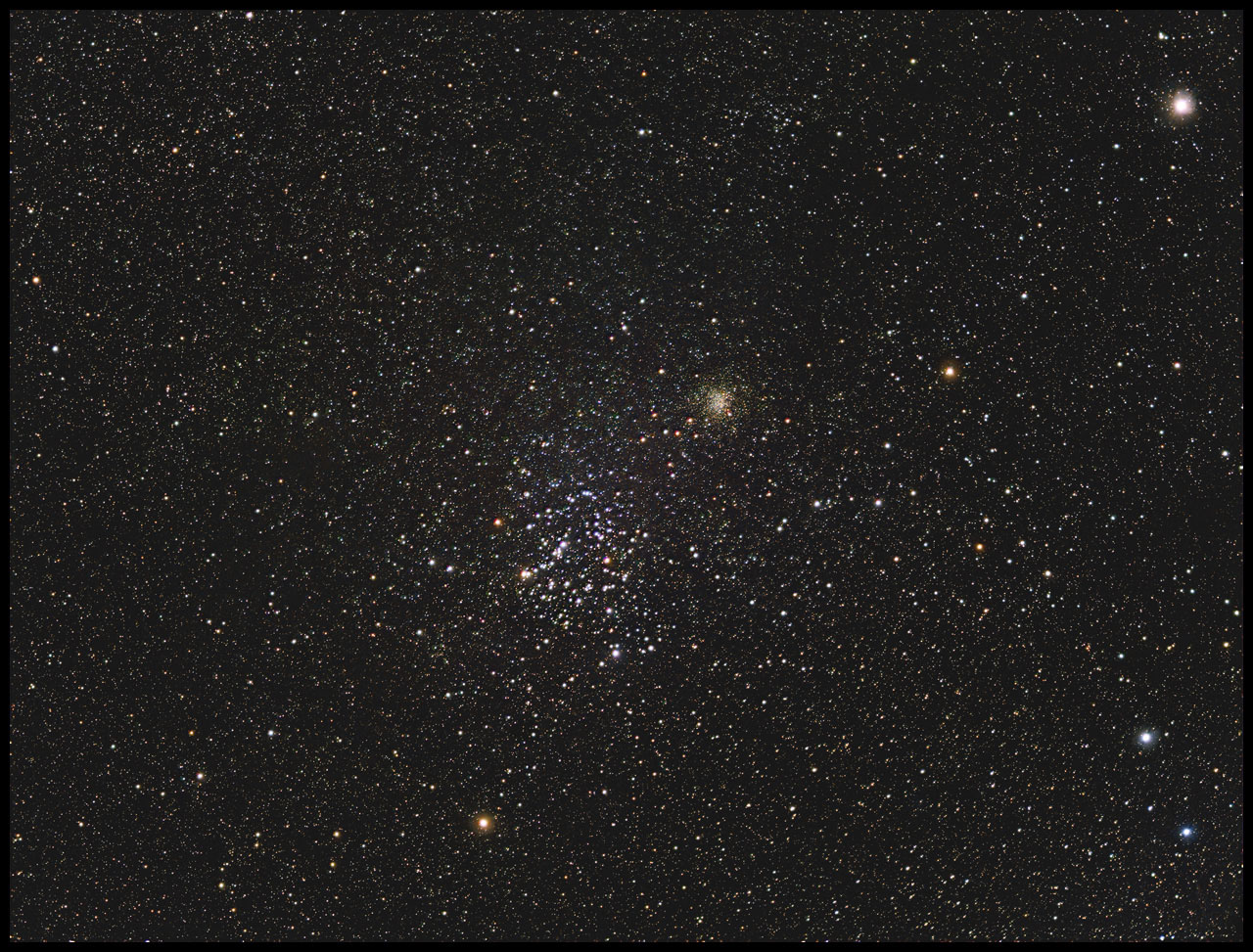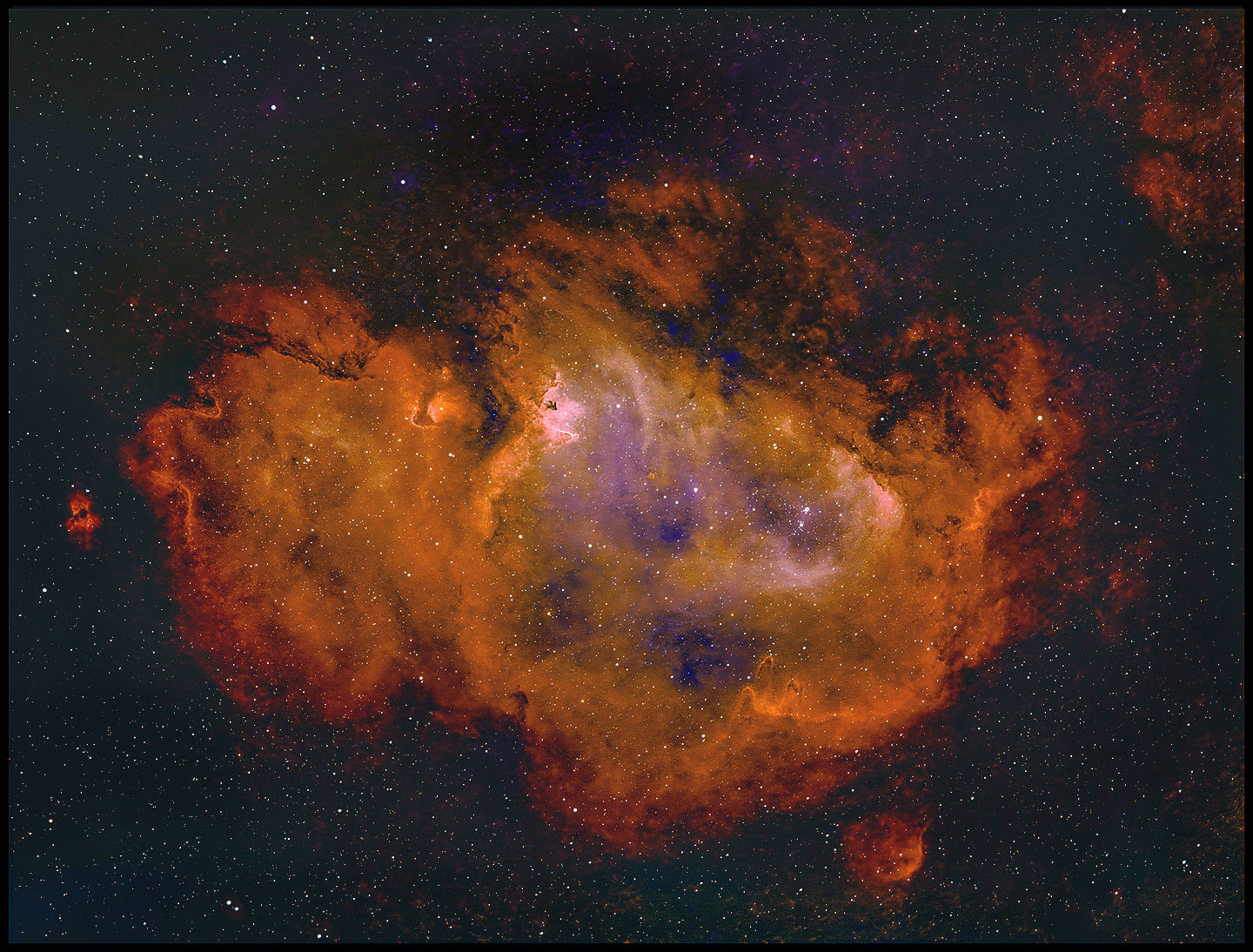More Super Telephoto Sport
2025/02/22. There is enough range in the focusing rig to reach focus with the Duoband filter and with the UV/IR, just. Replacing the twin hex nuts with an actual locking nut and fiddling a little with the drive-mount ring might make things less edgy. Tonight I've redone IC 405 with guiding, 180s subs, and painter's tape to discourage the focus from drifting. Total guiding error averaged around 0.7 arc seconds with the short-focus 50mm converted finder, the 120Mini camera, multi-star selection and 3-second integrations in PHD2. All this worked; your job is to make it big:

IC 405, AE Aurigae
24x180s (1h12m), 400mm F2.8
ASI1600MC, gain 300, -15C, Svbony Duoband filter.
BlurX, NoiseX, AstroFlat.
A brief take (60x60s) in white light (UV/IR cut) of M81 and M82 and environs was not particular impressive, but it did verify that the focus was good. Still -- if could find some extra room for just a bit more adjustment, that would be good. And I'll keep using the painter's tape until I know it's superfluous.
2025/02/23. Do I need two UV cut filters? There's the one semi-permanently installed in the 400mm's filter drawer and then there's the ZWO version mounted in the camera. I'm not sure the Nikon filter also cuts IR. And I'm not sure whether doing without the ZWO filter will help or exacerbate focusing issues. I made a half-assed attempt to see if I can use only the former with some photos of the Pleiades, but poor focus and twilight interfered with the results: some looked fine, but the best result came from a series of exposures using both filters. There were so many factors in play that I am unconvinced. Must try again soon. Here's M35 and NGC 2158 with both filters in place:

M35, 400mm F2.8
90x60s, ASI1600MC, UV/IR cut, -15C, gain 300
Enbiggenify at your pleasure.
Guiding is solid at around 0.7 arcsec RMS with 3-second integrations; focus remains troublesome. I reworked the drive linkage for the fine-focus tangent screw. It's simpler, not quite so smooth, but has at least half-again as much range as before. Plus, I think it will drift less. See previous page.
I focused carefully on bright stars within the Pleiades and left the Bahtinov mask in place. Half an hour later, the pattern had indeed shifted. Not a lot, but some. I tweaked focus, taped the ring, and began a series of 60s exposures. Maybe I should put the elastic anti-slip band back in place.
Changed batteries in the computer, adjusted polar alignment, changed filter, refocused on Capella, realigned on NGC 1893 (a cluster adjacent IC 405, all bound up with Sharpless 230 which hosts "The Tadpoles"), and began a series of exposures to extend the IC 405 field to the east. This time, I did not wait for the focus rig to relax (or whatever happens). The starfield the guidescope saw was a little less rich (or the sky a little hazier) and I needed longer guide exposures (6s) to find solid guidestars. Errors are a little worse (0.9" RMS vs 0.7"), but it's all hanging in.

24x180s times two
Same techspecs as IC405 image.
If you never make any of my pix big, make this one big.
I need to check the individual frames in CCDInspector to see what, if anything, changed during the course of last night's second run, but it's looking pretty good from here.
2025/02/25. Because I can't remember squat these days, here are notes about setting this up in the field.
Cabling and options:
RJ11 :: ASI120Mini to CP3
USB :: ASI120Mini to ASI1600MC
USB
:: ASI1600MC to computer
12v :: battery to CP3
12v :: battery to ASI1600MC
PHD2 options: tk
ASI Studio options:
tk
Tonight's lessons: I focused on Capella and began a series on the Heart Nebula. About 90 minutes later, I found that focus had drifted. Don't forget to use the tape. Try the anti-zoom band again, too. Also, I reloaded last night's guiding calibration which may explain why tonight's guiding is relatively poor (1.8" or so). Maybe take the extra four minutes or so to recalibrate each night. But hey, Magic! BlurXterminator fixes all:

IC 1805, the Heart Nebula, in Cassiopeia
400mm F2.8, 48x180s, Duoband filter
ASI1600MC, -15C, gain 300. Stars and nebula processed independently.
2025/02/26. I see why IC 1805 is called the Heart Nebula, but I have no idea why its neighbor IC 1871 is "the Soul Nebula." Is it just a play on an old song? You can see them together in a 105mm frame a few pages back, and that's one ventricular wall barely sneaking into the frame at upper right in the image below. The anti-slip band worked great tonight. So did a fresh guide calibration (total RMS error was still high --1.2"-- but better). I need to tweak the exact placement of the tangent screw's clamp straps so that I can orient the camera E-W without having the hardware conflict with the lens's handle/mount -- a few minutes with a screwdriver will be all that's needed for that. (Done.)

IC 1871, the Soul Nebula, in Cassiopeia
400mm F2.8, 40x180s, Duoband filter
ASI1600MC, -15C, gain 300. Stars and nebula processed independently.
CCDInspector confirms that there is some sag in the optical train. I can see it and feel it, but it's nice to have it brought to numbers. PSFs range from 6" to 9" across the frame. Pixels are 1.92" on a side which is 2.77" on the diagonal; each superpixel behind the Bayer matrix has a diagonal of 5.5". I'm not losing a lot of sharpness or image consistency to the sag --especially with an effective deconvolution utility-- but it bugs me anyway. A Nikon-T2 adapter would simplify the Nikon-Canon-T2 chain. But not today.
That's about enough for this page.
:: top :: |